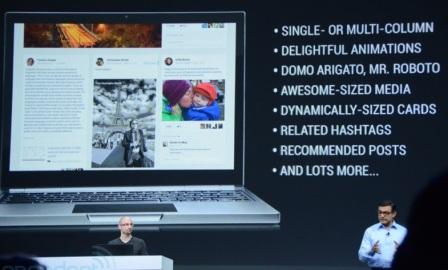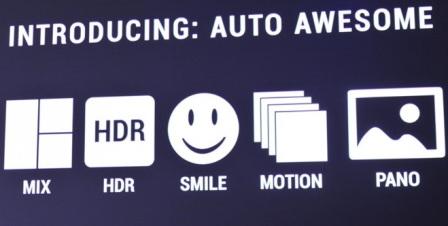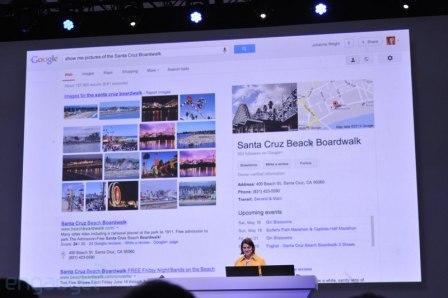With over 6,000 developers on hand, along with a fairly sizable contingent of media, anticipation among all of us attending Google I/O 2013 was for updates on Google Glass (though we have some Google Glass updates at this link), news of the Motorola X Phone (supposedly the next Nexus phone), a Spotify competitor, another Google TV iteration, details on Android Key Lime Pie, a smart watch, and then “the rest of the stuff” one would expect to hear about. Well, there was no new news on any of the things we’ve just noted (with a sort of exception to Spotify).
But there was, nevertheless, a lot of important information and innovation unveiled related to the “other stuff,” and the story isn’t a short one. The keynotes were capped by CEO Larry Page, who expressed a great deal of sadness about the state of technology, and who hosted a substantial Q&A session. More of that later in our story.
We’ll scope out high level details of the opening day suite of keynotes and what Google did announce – almost all of it having to do with the nature of the event – with a focus on core Google platforms for developers. There was a strong theme underlying everything, that of “getting technology to do the hard work and get out of the way” of people living their lives.

There was a great deal said of Android and Chrome in terms of their evolution, but the discussions tended towards the 20,000 foot view rather than specifics. Of course, the next two and a half days will be full of technical deep dives into all of it. There was a great deal of information about the next generation of Google+, which to us is beginning to look quite decidedly useful. There were details of the next two versions of Google Maps, and there were details of the next generation of search, where the goal becomes to anticipate and deliver answers, and where different platforms will begin to interact and share information.
We’ll cover each of these topics in depth and in separate articles over the next several days. The day’s key highlights included the overviews that follow.
Android and Google Play Music All Access
As we noted above, there were no details for Android Key Lime Pie. Rather, the true focus of the day was on Chrome – both the browser and the OS, especially as it relates to the chromebooks that are now emerging, as well as to Google’s own Chrome Pixel “state of the art” Chromebook – which Google distributed to everyone at the conference, including ourselves. We’re certainly looking forward to putting it through its paces. Before we look at Chrome however, let’s tackle Android.
Here is the key number on Android, which in truth says quite a bit: At the end of 2012, there were 400 million Android activations. In 2013, through this week, there are now 900 million activations of Android in total, so that means 500 million new devices were added to date in 2013. That is, in fact, quite an achievement.
Along with the operating system, there are, of course, the apps. To date, there have been 48 billion installs of Android apps via Google Play. And for developers, the numbers that count are just as good; Google has paid out more dollars in the first four months of 2013 than it did in all of 2012, with revenue per user growing to 2.5 times better than in 2012.
To go with these great numbers, Google is introducing a number of new developer tools and APIs that will help developers not only to build out new and more sophisticated applications more quickly, but that will also help developers better market and monetize their apps. These will take the form of new services as part of the Developer’s Console for Google Play and will include optimization tips, app translation services (to different languages), referral tracking, revenue graphs, testing in the form of staged alpha and beta rollouts and managed rollouts of final versions.
We won’t go into details here, but we’ll note that the new tools also include a new “Android Studio” developer editor and ecosystem based on an existing platform that includes advanced new tools provided by Google. The audience was quite appreciative of the few new capabilities that were demonstrated.
There will be new location APIs and geo-fencing APIs, the ability to create single sign-on capability across hardware platforms and a new API set for gaming called Google Play Gaming Services. These services will include the ability to build in achievement and leaderboard capabilities, multiplayer capabilities across different devices (Android and iOS smartphones and tablets as well as Web-based laptops/desktops). The most interesting new service we believe will be the ability to save game progress up to the cloud, which will allow players to resume their games wherever they leave off.
There is also a redesign of Google Play about to be launched. There is no need to go into details on this, but there will be improvements for quickly getting to the details of given apps and there will be a filter for pulling up tablet-optimized apps.
Also announced today – though we must admit it was announced without any real fanfare -- was Google Play Music All Access. A Spotify competitor? We’re doubtful of that, but it does put another music service into the mix. For $9.99 per month ($7.99 per month if you sign up before June 30, 2013) you gain access to all of Google’s millions of available online songs. The service will also attempt to understand your interests and will build playlists for you based on that understanding. The idea is to help you “expand your world” but to also keep the technology as hidden as possible.
Chrome
Google is working on numerous improvements to the Google Chrome environment as well as to the underlying services that will become available to the OS and browser. As of today, there are 750 million users of the Chrome browser, and many of these users are using it on mobile devices. The Chrome Pixel laptop, with its high resolution touchscreen, is Google’s attempt to show state-of-the-art possibilities for taking a Web-only, browser-only approach to computing.
Numerous improvements include a new image compression algorithm dubbed WebP that Google claims is greatly superior to jpeg, and which includes delivery of animated images. A new video compression algorithm dubbed VP9 is claimed to deliver as much as 50 percent better compression than H.264 and will be fully supported by YouTube. And there is new wireless data compression for Chrome on mobile devices that will effectively reduce wireless data costs enhancing a user’s ability to use more of it (through Chrome, of course).
We’ll also mention there is a new game about to be released specifically for Chrome called Chrome Racer that will allow multiple users to race against each other; mostly the point is to show off what becomes possible over the Web on the game front. It is rather cool.
Google then sought to bring a more important point home, using education as its example. The company strongly believes that Web-based tools such as tablets and Chromebooks and the sophisticated Web experiences that will go with them are ideal for bringing key educational tools to every conceivable market – especially, given the Chromebook’s and Nexus tablet’s relatively low cost -- including underprivileged countries.
The goal for Google in Education is to drive access to sophisticated technology to all educational environments. It’s important to note that there is a distinction here between supplying a “cheap” notebook and supplying an entire end-to-end experience with a wealth of sophisticated tools as its foundation.
Google+
There is a great deal going on with Google’s key large-scale platform apps. With new iterations of Google Maps, major improvements to Google+ and – finally – the beginnings of a real next generation of search, there was lots for Google to speak about here.
True, it all lacks the impact of Google Glass or the kind of impact new products (a smart watch or new Nexus phone) would engender, but this year Google has moved more directly towards beginning to take its social networking tools (and we think of Google Maps as such a beast) to new levels. Even search moves forward to some degree along these lines.
Google+ will gain a total of 41 new features, but the major areas of improvement will fall into three distinct categories: Stream, Hangouts, and photos. Google claims that there are now 190 million monthly active users in the Stream and 390 million active monthly users across Google and the Web. An interesting statistic to note is that 40 percent of people who use Google+ Sign-In will also install a Website’s mobile app if one is offered.
Google+ will get a new interface (shown below) that will seek to provide a more “immersive” and more visual experience (sounds like Glass) that aims to reduce clutter and provide deeper access into the things important to a specific user. Conversely, there will also be more to explore, using what Google refers to as “Related Hashtags” that will allow a user to explore related content on posts and topics of interest. In keeping with the themes for Android and Chrome, Google+ will also look to interact with multiple device types, and will specifically look to bring Web and mobile experiences closer together.

Google+ will also offer an extension to Circles called Hangouts. The point behind Hangouts is to deliver enhanced ways to communicate on specific topics, take note of when people are engaged and to maintain and retain ongoing conversations with your contacts. Conversation threads will be easy to maintain and manage, and there will always be full access to contact info. Photos and other things such as emoji (emoticons) are also simple to include. Friends will be reachable even when they are offline.
Our favorite new Google+ feature, however, is the addition of video calls. Any conversation can quickly be turned into a video call with up to 10 friends. We believe that another aspect of this is that it offers an excellent way to collaborate informally with co-workers. Conversations can fall in and out of video chats (which, BTW, are essentially free) as conversations require. Hangouts work on desktop, Android and Apple devices, so everyone can easily participate from anywhere.
Google+ Photos was an interesting surprise. Playing off the fact that most social networks are used to display photos, Google has taken several interesting steps to put a variety of Google technologies to work to make posting photos extraordinarily easy.
First, all of a user’s photos are backed up and organized and are accessible from any device. Google will now search through your photos and will actually select those from a group for display; Google will analyze photos for duplicates (and near duplicates), look for items such as similar people, not use photos that are blurry or otherwise not viewable and even try to associate known landmarks (say, the Empire State Building) within photos and make them more likely to be included in what is presented.
How many collections of 600+ photos do you have in hand? Simply ask Google to return what it believes are the top 10, or 30 or 50 or whatever subset you might want. Chances are quite high it will find the same ones you would have spent hours sorting through (it’s all about Google putting its search algorithms to good use).
Photos will also be “Auto Enhanced” to make subtle yet notable improvements in lighting contrast, skin tones, noise removal, etc. (all the usual suspects) that will help photos look their best. Furthermore, all of these changes can easily be undone. It’s a great idea, in fact. Google has also taken this to a new extreme of sorts with a new feature called “Auto Awesome.” Google will create, on the fly, from collections as they are uploaded, fun new images from the photos that are added to Google+. Initial capabilities are shown below.

Auto Awesome will look for opportunities to create short animations, panoramas from landscape photos and even group photos from different set that feature the same folks. Will this really work? We won’t know until we try them; in any case, it doesn’t cost anyone any time or effort and if you don’t like them, simply delete them. There will be plenty of storage available (15 GB at full size for each photo), so perhaps the best advice here is simply to enjoy the show.
“The End of Search as We Know It”
That quote is exactly how Google describes its new search capabilities. We’ll take a closer look at Search elsewhere, but the highlights are well worth noting. Improvements hinge on the Knowledge Graph and voice search and response. Google is targeting the delivery of an intuitive and “beautiful” experience across any device that also knows to stay out of your way when it isn’t needed.
New additions aim to deliver a truly conversational assistant able to answer an increasingly broad range of questions, and will look to provide the right information at the right time without the need to ask for it. We can summarize these features as answer/converse/anticipate, and they extend the use of Google Now. Below is a photo of a person interacting with Google verbally (yes, it all starts with “OK Google”) and getting back both website content and spoken details.

The Knowledge Graph is central to the entire effort. It now maps out how over 580 million things in the real world are connected and has 21 billion facts about them. Chances are that what you want to know (and many of the things we want to know about are common things) will already be noted there. New Google Now functionality adds reminders, public transit commute times and improved recommendations for books, music and so on.
Google Maps
There is a lot to “show” with Google Maps; it’s far more interesting to get the visual cues than to try and describe new features. We don’t have the space to do that here, but we’ll provide at least one view. There are currently one million Websites using Google Maps, which deliver about one billion views per week. Keeping with the general theme of exploration and discovery, the next iteration of Google Maps will focus on improving the mobile experience as well as on delivering a clean and uncluttered user interface, as well as enhanced 3-D renderings.
New features will include transit information and arrival/departure times, new live alert and rerouting (which sounds a lot like Waze), as well as a new tablet-optimized version. And, of course, there are new Android and iOS SDKs for developers to work with.
It isn’t completely easy to tell what’s different, but it is a much cleaner view of what we are currently used to. In any case, below is an image of the new 3-D rendering capability.

The version of maps described above is due to be released imminently. That said, there is another “future” version of Google Maps coming our way that delivers a much greater level of immersion. In fact, Google has begun to present this next generation through the concept of “the map as the UI.” Maps will be redrawn constantly to include and exclude whatever information the user decides is valuable or not valuable. There are plenty of street-level views, but also 3-D 360 degree views of internal places, such as what the inside of a restaurant looks like. There may also be ratings for places, and if anyone on your contact list has reviewed a place, Google Maps will let you know.
There is much more to tell, but if you are interested in scoping it out, drop by the website for the new version of Google Maps and request an invite to participate in a preview.
Larry Page is Saddened
Finally, once the presentations were done, Google CEO Larry Page (who just a short few days ago acknowledged to the world that he has a paralyzed vocal cord that makes it very hard for him to speak) took to the stage and delivered some remarks focused on his dual amazement at how far we’ve advanced with technology but at the same time how little we’ve really accomplished. He stood there, as shown below, with a huge backdrop of the entire Earth under a night sky, shown in a view with the Sun behind it (an image rendered from the new, new Google maps) and provided some clearly heartfelt thoughts.
.jpg)
Echoing the ongoing conference theme, he said, "Technology should do the hard work so that people can get on with the things that make them the happiest in life." Then, after acknowledging all of the progress that has been made, he noted that, "We at Google -- and all the industry, all of you -- are really only at 1 percent of what is possible. Probably even less than that…” And he specifically noted that this saddens him. He also went on to note that he is constantly saddened by a world in which the media is constantly framing things as Google vs. this or that company, or this or that company vs. Google. He finds these things enormously uninteresting and wants to be involved with creating things that do not yet exist. There were pointed comments about Microsoft and Oracle as well, but we’ll leave those behind.
Then, to our surprise, he queued up the audience for a long Q&A session. We won’t go into the specifics of the Q&A, but there were lots of interesting questions from a wide variety of folks that ranged from us media old timers to extremely young and very well spoken developers. It was an excellent Q&A. The image below happens to be of Greg Roberts, the CEO and chief designer of dSky9.com, who’s deep into Glass and who will be a speaker at our upcoming 2013 Wearable Tech Conference and Expo. Of course, he was asking a question about Google Glass. He was one among quite a few Google Glass wearers in the crowd.

All in all, it was a long morning of keynotes that ran until after 1 pm. And it was well worth the effort to pay attention. There is much going on at Google of great interest and importance – and interestingly none of it had to do with any of the noise and speculation that preceded the event, as we noted at the beginning of our tale.
We would like to acknowledge that the images presented here are courtesy of Engadget.com.
Edited by
Rich Steeves